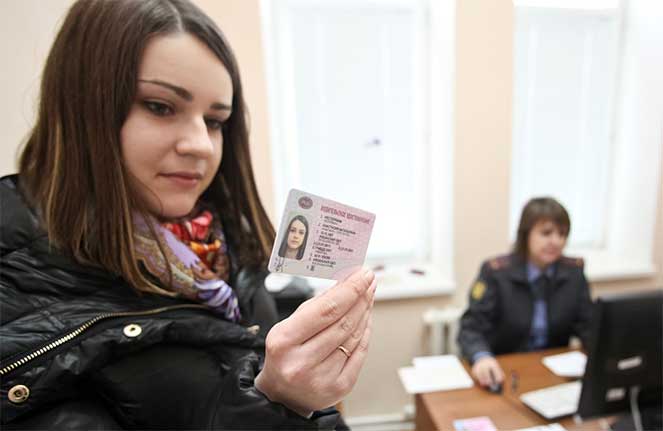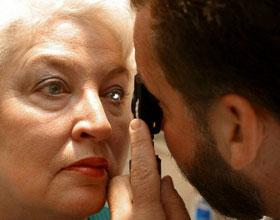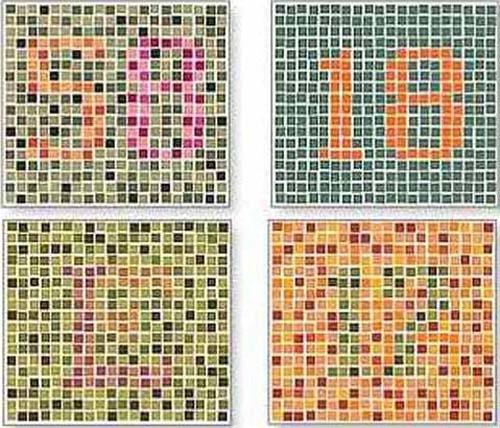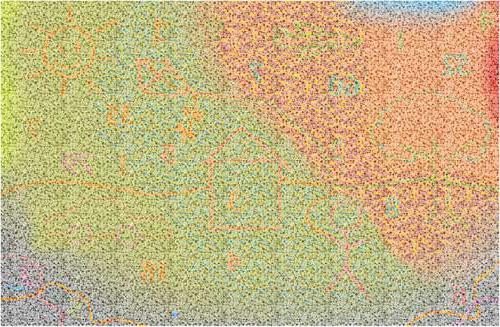Do color blindmen a driver's license. Color blindmen allowed to drive cars
Procedure for obtaining driver's license in Russia begins with the passage of the medical commission. And for those who have contraindications to driving a vehicle for health, it ends there. Among the diseases that traditionally implied at least significant limitations on the possibility of driving are, in particular, color blindness. Therefore, the problem of color blindness and driver's license in 2017 deserves detailed consideration.
Color blindness is a profound pathology of vision, manifested in the inability of a person to distinguish between different colors. This is due to medical contraindications and restrictions associated with the admission for the wheel of a person suffering from this disease. It is believed that such people are a potential source of emergency danger due to problems with the recognition of traffic lights.
For their part, opponents of the restrictions say that even those who suffer from shortsightedness have even more problems with this part, and this category of people who want to get rights has much more chances to realize their intention.
The structure of the retina includes receptors responsible for the recognition of various colors - green, blue and red (the rest are the result of mixing these). This function of the receptors is performed due to the presence of a special pigment. If it is not sufficiently developed or not at all, problems begin, the consequences of which are problems with color discrimination.
Basically, this pathology is innate in nature and is often transmitted to the child from the mother, who herself may not have such problems. It also happens that color blindness develops as a consequence of injuries and diseases of the eye.
In total in Russia, according to statistics from the Ministry of Health of the Russian Federation, 8% of men and 0.5% of women suffer from color blindness.
What sets the law
From the beginning of 2012, the order of the Ministry of Health of the Russian Federation No. 302n of April 12, 2011 came into force. It is he who now determines whether color anomaly and driver's license in 2017 are compatible. And I must say that the position of Russians suffering from color blindness has significantly worsened this document.
Until 2012, they had at least some chances, since the determination of the depth of the pathology and the possibility of admission to the management of the vehicle in connection with it was determined by an oculist during the examination. In practice, the color-blind persons usually discovered the “A” (motorcycles) and “B” (cars) categories without problems.
Restrictions were practiced only with dichromasia. This type of illness deprived the driver of the opportunity to earn such a profession for a living, but did not rule out the possibility of driving a personal car or motorcycle.
Doctors call dichromasia a kind of color blindness in which the patient is completely unable to distinguish one of the colors.
Dichromasy and driver's licenses in 2017 are completely incompatible, but now they suffer from this type of disease in the same position as Russians who are subject to its other forms.
With the entry into force of the said order, the ability to drive vehicles was closed to all applicants driver's licensewho are diagnosed with color blindness.
Those who managed to get driver's licenses before the commencement of the order turned out to be in a better position: not only no one is going to deny them rights, but they are not foreseen problems with their renewal or replacement and passing of repeated medical examinations. 
How to check the vision of future drivers
Tests for color blindness are an integral part of the professional examination of the future driver in the office of an ophthalmologist. For the diagnosis of color blindness, special color tables are used. Depending on what the patient sees on them and whether he sees any meaningful images at all (usually figures and figures), the oculist draws conclusions about the presence or absence of the mentioned pathology. Such tables are used, as a rule, 27.
What is important to know the future driver - there are some stringent requirements for the procedure of such testing:
- during the procedure, the window should be placed behind the patient;
- tables should be placed strictly at eye level at a distance of one meter from the patient;
- the doctor should show each table within 5-7 seconds;
- testing is carried out only with natural light;
- it is unacceptable to carry out procedures if the patient has a temperature higher than normal or other symptoms of certain diseases are present.
If any of these requirements is violated, the future driver will have the right to challenge the diagnosis, which in 2017 actually sounds like a sentence.
Procedure cost
If a professional examination of the future driver is carried out in the municipal clinic, he should not pay anything, it is enough to have an OMS policy. In paid clinics, the total cost of a driver's certificate automatically includes all procedures prescribed by law, and there is no need to pay extra.
If desired, the test for color blindness can be taken separately - before contacting medical facilities for driver's reference. Depending on the region and the pricing policy of a particular medical center, this service will cost an average of 0.5 thousand to 2 thousand rubles.
Different categories of color blind
Doctors distinguish three types of color blindness, depending on the colors with which the patient’s problems arise:
- Deranopia is the inability of the patient to perceive the green color. Instead, orange and pink are seen as so sick. Of course, when it comes to traffic lights, they can be recognized by location. However, proponents of restrictions for this category of patients insist that there are different situations on the road: in dim lighting or in a stressful situation, it can be difficult to assess the location of the signal, and its color is of key importance. To confuse color signals is fraught with dangerous consequences, not only for the color blind, but also for other road users. However, until 2012, deiranopia and driver's license were considered quite compatible.
- Pronatopia is usually called the inability to distinguish the color red. His patient perceives as dark green or brown. The inability to distinguish red from green, that is, the main signals of the traffic light, was a decisive argument in favor of those who claim that pronatopia and driver's license are at least a dangerous combination.
- Dichromasy, as mentioned above, is a complete inability to distinguish one of the colors. This is the most severe form of color blindness, implying restrictions until 2012, when the approach to granting a color to a driver’s license was more liberal.
After all of the above, the answer to the question of whether a color blind person can get a driver's license is, alas, obvious: they have no legal opportunity for that. The question of how this state of affairs is justified and fair, remains, of course, debatable. However, as of 2017, the state represented by the Ministry of Health of the Russian Federation, which issued the above-mentioned order, has clearly indicated its position on this issue, and there are no plans to revise it. 
Meanwhile, in many foreign countries, the question of whether a driver’s license is given to color-blind persons has a radically opposite answer. In particular, in a number of European countries, the inability to distinguish colors is generally not considered a contraindication for a person’s admission to driving a vehicle. So the Russians with color blindness have a theoretical opportunity to get around this limitation. The legislation of the Russian Federation allows its citizens to enjoy foreign rights, including in Russia. Problems can arise only when they are exchanged for Russian, because for this you will need to undergo a medical examination.
However, there is nothing unchanged in the world, and it is possible that the approach to whether a color-blind person can get a driver's license will undergo changes in Russia.
It would not be superfluous to say that color blindness is not the only diagnosis that makes it impossible for a Russian to become an owner of a driver's license.
What happens if you hide the disease?
It is not a secret for anyone that many paid medical centers in Russia, which offer the service of a driver’s medical board, in fact simply sell certificates. For example, in Moscow, you can find offers whose essence is that the patient is only required to order a certificate and receive it in exchange for money delivered to your home - without a visit to the clinic and undergoing a medical examination.
Naturally, the ability to get the desired document in this way opens up for the color blind. However, it should be understood that for falsifying the results of medical examinations it can be up to two years in prison (Article 327 of the Criminal Code of the Russian Federation).
In addition, if it turns out that the rights were obtained on the basis of a fake certificate, the investigation may see signs of fraud in this (Article 159 of the Criminal Code of the Russian Federation). And if it also turns out that the owner of such a certificate had previously passed a physical examination and had been diagnosed with color blindness, the fact of having malicious intent can be considered proven.
Nothing good is expected by the law and those who enjoy fake rights. If you identify a fake for it shines a fine of up to 80 thousand rubles.
Color Blindness: Video
People who have vision problems tend to be restricted in some areas of life. This also applies to transport: color blindness and driver's license in some cases they are so incompatible that some citizens remain pedestrians for life.
Sight for driver's license: features that you need to know
To obtain a driver's license of the established pattern in the number required documents is presented medical certificate. According to this document, the driver undergoes a medical examination and the medical board determines whether he is fit to drive or not.
According to the order of the Ministry of Health and Social Development of the Russian Federation No. 302n, there is a list of diseases in the presence of which access to driving is prohibited. In particular, this also includes some types of visual impairment that could affect the car’s handling.
In short, you can identify several features of the vision, which affect the ability to obtain rights:
- Decreased visual acuity. Usually, the sharpness is checked with the help of the well-known letter table. Naturally, there are craftsmen who try to memorize the letters and call them in the correct sequence. For such citizens, other test tables are provided that can also determine visual acuity. Each category of rights requires its own indicator. Moreover, in the above order, there are two categories of vision: “with correction”, that is, with glasses or contact lenses, and “without correction”, that is, without them. For example, for category V, the vision on the “best” eye without correction should be 0.8, on the other, visual acuity may be absent; in the presence of contact lenses or glasses for the same category, the “best” eye should see at least 0.5, the worst - 0.2.
- As mentioned above, the future driver can come to the ophthalmologist with glasses or contact lenses to the medical board. But even in this case, not all are suitable, but only those in which the diopters are not lower than -8 and not higher than +8. The difference between eyesight should not be more than 3 diopters. But sometimes there can be cases when a healthy eye under the glasses can give distortion, and “not reach out” to the required number of lines. This is the so-called "lazy" eye. It is easily amenable to correction in infancy and adolescence, but adults can also “tighten” their eyesight.
- One of the important characteristics of the eye, which is considered on the physical examination for the admission of a citizen to the management of transport, is the color perception of the eye. This characteristic is important so that the driver can at least recognize the colors of the traffic light.
- And finally, there are diseases in which admission to driving a car is not allowed in any case. For example, this can include glaucoma and retinal detachment.
Color Blindness and Driving License
According to the research, almost every 10th man on earth is color blind. And if you pay attention to the drivers, almost every second is a man. The statistics are sad, but the fact that color blindness is mostly a masculine disease is not denied by scientists.
The current order No. 302n in its provisions is rather “strict” with drivers: a violation of color perception is the basis for refusing to issue driving license. Or rather, until you get the rights, no one will even allow you!
 Previously, everything was “softer”: a violation of color perception was allowed for both category “A” and category “B”. An exception was made only in one case: dichromasy and driver's license were incompatible.
Previously, everything was “softer”: a violation of color perception was allowed for both category “A” and category “B”. An exception was made only in one case: dichromasy and driver's license were incompatible.
For many drivers, such standards caused misunderstanding; there are several different types of color blindness, so why not make an exception for those who can not distinguish only one color? For example, for citizens who suffer from myopia, it is much more difficult to drive, but they are given rights!
In this case, numerous studies conducted by scientists say that if a person can easily distinguish the colors of a traffic light, then he should not have problems with driving a car.
Not all countries are so "categorically" relate to color blindness. For example, in Europe they are trying to invent a special form of a traffic light, at which even a colorblind cannot confuse a signal: as a rule, at such traffic lights, each color has its own shape (red - triangle, green square, orange - circle). In addition, you can make traffic lights in which there will be a voice countdown, etc.
Of course, there are many ways to “get around” the official medical examination, pay and receive a “fake” certificate. But in this situation, it’s worth thinking not only about your own safety, but also about the safety of other road users, since with eye diseases the driver may simply not see some kind of obstacle and create an emergency situation that will result in the death of innocent people. .
Having certain health problems, many citizens can not lead a full life, manifesting itself in different fields. This also applies to vision problems. For example, concepts such as color blindness and driving licenses for many, and remain things incompatible. That is, people with such a diagnosis in 2017 can remain forever pedestrians.
Features of the diagnosis
The main distinctive feature of color blindness is the inability of the eye to distinguish colors among themselves.
Responsibility for this is borne by the retina, which is located inside the eye, and transforms the light stimulus in such a way that the object is viewed in all its details and shades. In this retina there are three so-called light sensors, which have a certain set of protein pigments of red, blue and yellow colors. Other colors the human eye distinguishes when mixing the available colors.
Sometimes there are cases when some pigment is missing, or an insufficient amount of it. Then the person will not distinguish some shades. The disease is most often congenital, although injuries may subsequently occur, and whether to result from medication.
Types of color blindness
If the balance of perception of the color palette is disturbed, the person is likely to have one type of disease.
Among color blindness emit:
- trichomates, people, with a reduced perception of one of the flowers,
- dichromats, the retina of such a person has only two of the three working light sensors, hence the inability to perceive all colors and shades.
- monochromatic, a person is basically unable to distinguish the color palette, and sees the world around us only in black and white colors.
![]()
When there is unrecognizability of any color (dichromates), the diagnosis may be:
- tritanopia, when the human eye is not able to catch blue and purple hues, and instead of them he sees green and red colors,
- protanopia, the case when there is a shortage of red pigments, in this case, the eye will see dark green and brown shades,
- deuteronopia, when there is a perception of pink and orange instead of green.
Have a driver's license color blind: is it possible?
The disease is detected, usually at an early age, although cases of its occurrence in more mature age are not excluded. How to be citizens handed over the diagnosis, who want to be able to drive?
It should be understood that the disease is incurable, although there are special glasses abroad that help people in light perception. In our country, people suffering from color blindness have to be much more difficult.
The law, which entered into force in February 2016, informs citizens that people with color blindness do not have the ability to drive motor vehicles.
But this applies only to those categories of citizens who want to get rights for the first time. If the driver has a slight deviation in the perception of shades, but he received the rights earlier, this law will not be the basis for the termination of his driving experience.
Earlier, drivers with color blindness were allowed to drive vehicles only categories A and B. But in their document there is a special note, which informs that such citizens do not have the right to work as drivers for hire, but only use the vehicle for personal purposes.
Where are the test for color blindness when getting rights?
You need to know that not always color blindness will serve as a sentence to the inability of a person to drive a vehicle. Here you will need to go through the appropriate checks by an ophthalmologist and identify possible deviations.

- be tested in good health, because any deviations in health can affect the result,
- start testing relaxed to eliminate the possibility of distortion of light perception,
- during the procedure, it is necessary to achieve ideal conditions in the room: proper lighting, the location of the image at eye level, and the tables should be located no more than 1m from the subject,
- in avoiding erroneous answers, it is better not to rush and use all the allotted time.
For testing, tables of Rabkin and also of Felhagen, Fletchen, Ishihara are usually used. Each drawing has numbers or geometric shapes that have a weak selection by circles of a different color.
When the test is passed, the specialist considers the number of correct answers, and judged by the wrong one, the deviation in perception of what color is present (if any).
It is possible to undergo such a procedure in the district clinic at the place of registration, or online through the Internet. You can go and paid diagnostics in specialized centers.
That is, when this disease is detected, it will not be possible to officially obtain permission from the medical commission, since color blindness is a contraindication to driving. And the use of forged documents is punishable by law in the form of imposing penalties of up to 80 thousand rubles, as well as imprisonment for up to six months.
Therefore, people with insufficient light perception just have to hope that in our country they will create conditions for them to move along the roads and legally get a driver's license.
Even if you have never met a person who is unable to distinguish any colors, you need to say that color blindness is a fairly common disease of our time. Among the inhabitants of the planet can be color blind, not only people. Many animals are "owners" of color blindness. For example, the bulls are not familiar at all, but with fearsome predators, like lions and tigers, only blue and green are known. Similarly perceive the colors of cats and dogs. Walruses, whales and dolphins do not distinguish colors in general and see the world around them in black and white.
Why not all colors are available to the eye?
The retina of the human eye is a complex, multi-factor instrument of the organ of vision, which transforms the light stimulus and allows you to see the object in its exact form and with all shades of color. It is equipped with photosensitive cones containing a pigment responsible for determining color. A person has three types of light sensors located on the retina, the so-called cones. Each one contains a specific set of protein pigments. Speaking in an unscientific language, each of these cones is responsible for the perception of a particular color: red, green, and blue. In the case when one of the set of protein pigments is missing, the person loses the ability to perceive a certain color. In the normal operation of all three sensors, a person distinguishes about a million shades of color, but with two, only 10,000 (100 times less). Color blindness is a deviation from the norm when the work of at least one light sensor is disrupted.

People with color blindness hardly perceive shades, but can recognize colors by brightness or tones, cold or warm. Color blind people do not always know about their disease and do not notice their differences in perception from the sensations of other people. This helps them to memory. It is the memory and brightness of the image that allows them to judge a particular color and compare it with another palette.
Types of color blindness
Color blindness also has many varieties. Sometimes a person has less than three color cones since birth. From here and groups of people on perception of color:
Trichromates (normal, all three flasks of protein pigments function in the retina).
Dichromates (only two cones are functioning; problems arise with the recognition of many shades).

It was this deviation that John Dalton, an English natural scientist, identified in himself, and was the first to describe color blindness from a scientific point of view on his own feelings. He just belonged to the group of dichromates, when the red and green colors are seen as different. The first work on color blindness D. Dalton wrote at the end of the XVIII century.
Monochromats (only one type of cones functions; in this case, a test for color blindness will show that people do not know about flowers, the whole world is black and white for them).
Abnormal trichromats
There are deviations in people whose retina is equipped with all three light sensors, and it would seem that all colors should be perceived. The problem may lie in the so-called color failures. The fact is that, ideally, the sensitivity zones of light sensors of the eye, which are responsible for the perception of a particular color, should overlap each other, always evenly. This allows the eye to perceive all shades from one color to another: from blue to green, from green to yellow, from yellow to orange and beyond. When the sensitivity zones shift (overlap one another), they begin to argue, the shades become layered, the pure colors dim. The brain becomes confused and begins to define certain colors as simply gray. This is called abnormal tricolor vision.
Color blindness innate
Partial or complete inability to distinguish colors is a hereditary or acquired pathology (it is much less common).
Hereditary daltonism is a recessive sign of inheritance associated with the pathology of the X chromosome, therefore, more often the disease is inherited from the mother of boys.

As is known, the female embryo is a carrier of two X chromosomes. But for a normal perception of color, one healthy X chromosome will suffice. For girls, the disease spreads only when both mother and father suffer from color blindness. But in this case, according to the laws of genetics, color blindness in women who have only one chromosome with an affected gene that does not appear in the host, can be inherited by the son. But this does not necessarily happen. The gene for color blindness can be transmitted even after several generations. Again, the male population is more likely to be at risk.
According to statistics, women’s color blindness is recorded only in 0.1% of cases. Among men, 8% are color blind. With a hereditary factor, color blindness is, as a rule, a pathology in both eyes that does not progress with time.
Color blindness acquired
The main factors affecting the acquisition of color blindness are always directly or indirectly associated with either brain injuries or retinal damage. Sometimes a concussion in childhood can later affect color perception. In addition to childhood injuries, other factors can influence the acquisition of color blindness:
- Old age.
- Eye damage due to injury.
- Concomitant eye diseases (glaucoma, cataracts, etc.).
- Drugs that have a side effect.
Diagnosis of color blindness. Testing
Color blindness is a given that you just need to accept. He is not treated. This is the same as a musical ear: someone has it, but someone does not. Never need to do self-diagnosis. If you notice a deviation in the perception of color in yourself or your children, you need to contact a specialist. There are proven methods for determining color blindness and its type.
1. Rabkin test (polychromatic tables).
A test for color blindness in this testing is done by looking at the tables in which various numbers or letters are depicted. Readable images are applied using color spots that are the same in contrast and brightness. The result of the test will be the ability of the subject to recognize the desired numbers or letters in the images.

2. Test Ishihara.
A similar test in the form of tables, allowing you to more accurately determine the moderate, strong degree of color blindness and total color blindness. There is a complete edition of this test from 38 tables. They are used by professional ophthalmologists.

The shortened version of 24 tables is used for rapid testing at municipal institutions, airports. There is also a short specialized publication of 10 tables for preschoolers and illiterate people. Instead of letters and numbers in these tables, images of geometric shapes and various lines are used.
Color Blindness and the Human Profession
Limitations with which the choice of a profession for a color-blind can be connected are very important. First of all, these restrictions apply to professions where there is a responsibility for life, one’s own life or other people. Color blind people are not accepted for military service; they cannot be pilots of aircrafts, drivers of commercial vehicles and chemists. For these professions, annual medical examinations are required, which are admission to. If a person has a color blindness on examination, rights in his profession are sharply reduced. He may be engaged in theoretical training of young professionals, to perform office work related to their professional skills.
Color Blindness and Driving License
If in some professions color blindness is a sentence, then to get the restriction does not apply to everyone. Here the opinion of a specialist is important.

Driving license and color blindness - the concepts are quite compatible, but only after the conclusion of an ophthalmologist. Only the doctor determines the type and degree of color blindness, therefore, and gives permission to the patient to drive a private car. Color blind people can get the rights of categories "A" and "B", in which there must be a mark "Without the right to work for hire."
To help color blind
Scientists regularly offer new medical "gadgets" that can alleviate the plight of people with disabilities. It turns out, despite the fact that doctors can not fix cones-sensors, it became possible to reprogram the brain to the correct color perception. Today, special glasses have appeared, in which narrow spectral strips are simply “cut out” by lenses and pure colors are separated from each other. The principle of enhancing the contrast allows the red, blue and green colors to not mix.
Science has helped many color blind people to see colors of which they didn’t even suspect: purple, bright green and bright red.
A question regarding driver's license for color blind people interests many. The following describes the basic rights of these patients.
As it was before
In order to obtain permission to drive a car, you must pass a medical examination, including an ophthalmologist. In Russia, a patient with impaired color perception was not previously allowed to drive in categories other than A or B. At the same time, the certificate indicated that the driver does not have the right to work for hire, that is, he can drive a car only for personal purposes. In European countries, such restrictions have never been.
Many ordinary people believe that the color blind is not able to distinguish the colors of traffic lights. However, most patients are able, to varying degrees, to distinguish shades, this helps and a certain arrangement of lights at traffic lights. In practice, a color blind person is able to cope with the control of any vehicle, however, the law is not always on their side.
Many ordinary people believe that the color blind is not able to distinguish the colors of traffic lights.
Present situation
The situation has changed since September 2012, when the law on the prohibition to drive a vehicle to patients with impaired color perception came into force. When detected during a commission from a person, he receives a medical withdrawal.
This order with the number 302 caused a resonance, since it was regarded as discrimination. Previously, patients with minor violations of color perception of law could be obtained without any problems. Then only people with restrictions came under restrictions, in which there is a complete loss of one color. Now it turns out that even with minor deviations a person is deprived of the right to drive a car and a motorcycle. That is, even people who can distinguish the colors of traffic lights can not get behind the wheel.
If the patient has a slight violation of color perception and he has already received the rights, then he can drive. In other countries there are no restrictions for color blind people at all. In these countries there is a project to address the issue of color blindness on the roads with the help of various forms of traffic lights (not just round). In this case, no confusion with the signals can happen.
On the territory of Germany, special color lenses are produced for color-blind people, which are able to correct the color perception to some extent. In our country, such innovations are not expected. Restrictions for color blind people in Russia still cause outrage, but many people have found a way to circumvent bureaucratic rules. They make bogus inquiries and are given permission by an ophthalmologist to manage transportation. Some simply memorize color charts and cheat doctors.
